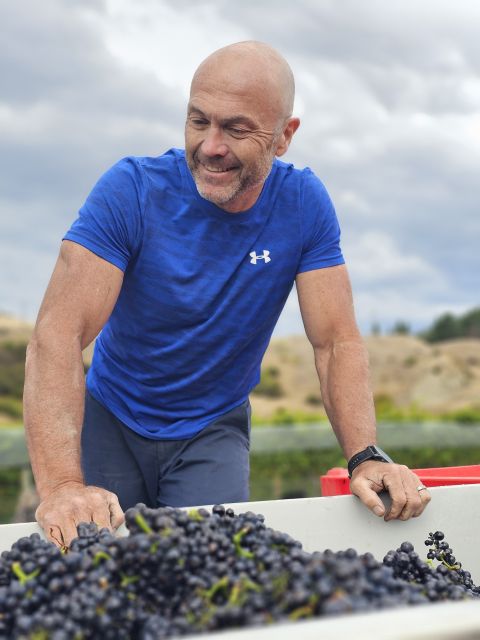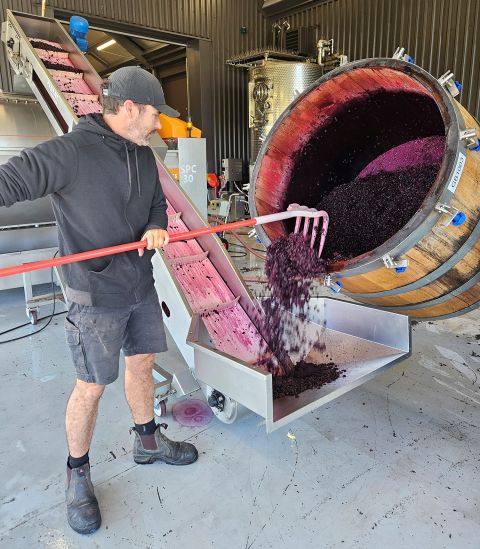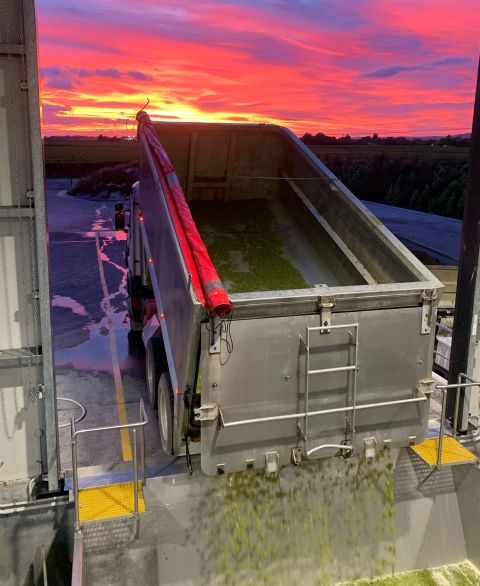New Zealanders are renowned for being direct and honest, sometimes brutally so, and frequently to our detriment. We tell it like it is. It’s why we’re not the best at marketing and are extremely careful about talking ourselves or our products up. To do so risks being cut down or ostracised because tall-poppy syndrome is pervasive in our society.
Our Aussie neighbours are far more adept at celebrating their success and championing their own greatness. One needs only to look at the fact that Cloudy Bay was started by an Australian to see this Antipodean difference in action.
Explaining this cultural peculiarity is necessary in order to highlight the significance of the words of the winemakers I interviewed for this 2024 New Zealand harvest report, and to acknowledge how difficult it is for us to say that something is the best – whether that be a wine (if it’s one’s own) or indeed a vintage.
A few were brave enough to say it was the best ever (or yet). Helen Masters of Ata Rangi was certainly in that camp, and when I caught up with Ivan Sutherland of Dog Point, he almost whispered to me in case someone overheard that he thought, in his 40 years in the Marlborough industry, it was the best he’s ever seen. Similarly, my business partner and husband Matt Thomson confessed that it’s the most outstanding vintage he’s had in his 63-harvest career (that’s both hemispheres every year since 1992).
Unlike last year, which had extreme variability in regional weather patterns, vintage 2024 was kind to all players with the North Island likely receiving a sincere apology from Mother Nature for her behaviour the year before. 2023 did feature some outstanding wines for the South Island in particular, and these should not be tainted by the perception of Cyclone Gabrielle’s cruel fury in Hawke’s Bay and Gisborne.
Similarities can broadly be drawn across all wine regions in New Zealand this vintage, with slightly more outlier activity for Central and North Otago. It was early and small everywhere except Central Otago, which reports above-average yields. Preliminary estimates for all other regions are 25–40% down on average. It was compact due to the lower yields and warm, dry summer, and many weather records were broken.
The saving grace was that despite the drought conditions across the country, the summer and early autumn were never oppressively hot and in fact it cooled down very quickly from early autumn, allowing for a relatively relaxed intake and excellent acid retention. This combination of factors – small yields, dry and warm conditions – meant that many highlighted the flawlessness of the fruit as a hallmark of the vintage. And as we all know, clean fruit and small yields are tantamount to perfection.
There is indeed an air of excitement as the ferments finish up and the true potential for outstanding quality is being realised. I attended an Appellation Marlborough Wine member event, playfully titled ‘Hazy Days’, where all 52 members submitted their pre-blended parcels of Sauvignon Blanc from across the wine region in the first event of its kind. A packed room palpitated with aromatic waves of tropicals and currants and the attendees were fizzing with enthusiasm for the unfinished, still very cloudy new wines.
When these wines hit the market is going to depend on a lot of factors, most obviously when the remaining stocks of vintage 2023 Marlborough Sauvignon Blanc will be exhausted. The appetite for this vintage has been unfairly marred by the misconception that the whole of New Zealand was impacted by cyclonic weather when it was actually a very high-quality vintage for Marlborough (and much of the South Island). Compounding this is the built-up inventories in markets as a result of the shipping challenges during COVID and consequent over-ordering to satisfy demand that was interpreted as here to stay. Consequently, wine producers programmed to grow, when in fact markets have contracted. We all know now that economically times are very challenging, with discretionary spending reduced or being eliminated altogether. Those who operate at scale are the ones hurting the most, and they will hurt more as a result of this vintage’s smaller yields (explained in greater detail below).
There is a glimmer of hope in the nascent signs of interest rates easing. Wineries and growers will go through some pain this year, but we are all so thankful to have been delivered a vintage that is, for most, nirvana.
Regional breakdown
Northland and Auckland
Comments from our two northernmost wine regions (see this World Atlas of Wine map) echo outstanding quality, particularly compared with 2023. Crops were low due to inclement weather during flowering, with Peter Jones of The Landing stating last season’s poor light and high rainfall also impacted flowering and fruit set, and exposed blocks copped a battering from the remnants of Cyclone Lola in late October.
However, from November through until after the end of harvest the weather in both regions was incredibly settled and dry. Michael Brajkovich MW of Kumeu River highlighted that summer temperatures were not that hot as they didn’t receive any highs over 30 °C (86 °F), where they normally would receive at least a couple. ‘We were waiting for El Niño, but it never really came’, he asserted. The harvest was wrapped up by 16 March, which was the same kind of time as the past few years but with volumes down about 40% on average. Kumeu River Chardonnay lovers take note.
Hawke’s Bay and Gisborne
El Niño did arrive on the East Coast of the North Island, much to the elation of its vignerons after two seasons significantly impacted by a powerful La Niña weather pattern. Steve Smith surmised that ‘across the board it’s a vintage that promises the opportunity to be exceptional’. Now’s a good time to remind oneself of Kiwi self-effacingness.
While spring was cool and unsettled, the frost events were minor and regular blustery weather patterns slowed progress by about a week. Like the north, a very unsettled, cool, wet period fell right in the middle of flowering in late November, which meant the later Chardonnay blocks and all red vineyards set lower crops, often with a reasonable amount of millerandage.
From December, the weather was exceptional for winegrowing, and unlike Kumeu there were 25+ days above 30 °C, yet none above 35 °C (95 °F), keeping vine stress levels in check. While December and February were dry, January had above-average rainfall which was perfect for canopy and berry development. Autumn arrived on cue in early March with dry and slightly cooler weather, creating perfect ripening conditions. Harvest was spread from early March with Chardonnay through until mid April with the later Syrah and Cabernets. Patience was key to achieve flavour and phenolic ripeness as well as sugar accumulation, which occurred rapidly, early on. The cooler March conditions allowed this.
Like elsewhere, yields were low across all varieties due to the previous season and poor flowering, but again the words quality and exceptional are being used together prolifically.
Wairarapa (Martinborough)
Helen Masters of Ata Rangi was just about to jump on a plane to Adelaide when I spoke to her, but her resounding thoughts were that she has never seen such different harvests back to back and that 2024 is the best vintage she has seen. Weather patterns began broadly identical with cool, wet weather during flowering impacting fruit set, but a dream run from December onwards saw sustained dry periods and warm but not overly hot temperatures. Absence of disease was a major positive for Masters, in stark contrast to the previous year.
Dry, cool temperatures through the harvest period allowed the fruit to come in with an excellent balance of sugar, acidity, flavours and ripe tannins.
Marlborough and Tasman
Jim White of Cloudy Bay sums up vintage 2024 for the top of South: ‘harvest was a dream’. Both Marlborough and Tasman experienced a dry winter and isolated spring frost events. Bunch numbers were slightly down on long-term average, which, coupled with a flowering period that featured some very cold nights and changeable daytime weather, led to a below-average set of berries and millerandage in those varieties and clones prone to it. Positively, bunches were much looser than average, which reduced the risk of bunch rot in the naturally tight Sauvignon bunches.
Both Marlborough and Tasman broke their respective records for the driest summer period. Marlborough experienced its driest 10 months in its 94 years of records (June–March), while it also had its second-sunniest summer on record (848.7 hours of sunshine). Drought was declared across both regions in mid March much to the relief of drought-stricken farmers. There was just enough rain in the headwaters to prevent the shutdown of the crucial water takes for irrigation in both the Wairau and Awatere valleys. While there were intermittent restrictions, they were thankfully short lived.
Berry size was restricted due to this low rainfall, but a hallelujah rain event on 3 March of 30–50 mm (1.2–2 in) over 1–2 hours was enough to freshen up thirsty canopies, recover berry weight and avert shrivel in the Pinot Noir, which certainly would have happened without it. The warm, sunny days and lower-than-average yields brought forward the start of harvest for both regions by a good two weeks. Cloudy Bay affirmed their earliest ever Sauvignon Blanc harvest finish, a full five days earlier than the previous record set in the similar vintage of 2021, and nearly everyone was wrapped up before Easter. But while early harvests are usually marked by lower-than-average acid levels, another critical feature of this vintage is that the cooler nights kicked in earlier, with some nights as low as 3 °C (37 °F) in early February.
A fast pace was needed as crops were ripening rapidly, but just as it looked like the ripeness might get away on winemakers, the days cooled down to the low 20s (70–75 °F). This allowed harvest to take place in a calm and organised manner. Ripeness levels were ideal, acid levels were excellent, and the disease levels were at record-breaking lows.
All varieties appear to have benefited from the near-perfect conditions. Early assessments show the 2024 Sauvignon wines will have remarkable freshness with a ripe fruit spectrum. Chardonnay and Pinot Noir also show superlative promise with profound concentration, aromas and richness.
Yields per hectare appear to be around 30% down on the long-term average, but with the increased producing area it’s likely this percentage will be slightly less.
North Canterbury
2024 saw a return to a classic North Canterbury weather pattern, with an unsettled, very wet spring followed by a long, dry summer with more than 10 days over 30 °C and, like the rest of the country, a slightly cooler, dry autumn harvest period. Advection frost events in mid September and again towards the end of October caused, in some cases, quite severe damage, especially to Chardonnay. In many cases frost fans did not work due to the nature of the frost.
Like Marlborough and Tasman, December through to April was markedly dry (120 mm /4.7 in of rain falling in this period). Harvest proceeded from mid March through until later April in exceptional conditions. Final yields varied across the region; however, quality appears exceptional, especially for Chardonnay and Pinot Noir from the vineyards where clay and/or limestone soils, and judicious irrigation on the lighter soils, mitigated severe water stress. A potentially truly great vintage awaits for those who managed the challenges of frost and were patient.
Central Otago and North Otago
Central and North Otago regions experienced a slightly different pattern to the rest of the country. Sunshine and rain were in line with long-term averages, while localised frosts in spring affected a few individual vineyards in the Pisa and Bendigo subregions. Critically, the flowering period was stable, warm and dry so there was an excellent, uniform fruit set and the whole region is reporting yields slightly up on average.
Jen Parr of Valli remarked that this vintage had warmer features to start with, followed by an unseasonably cool March which saw them waiting for flavour development in some areas and picking early in others. The season was very contracted and Valli picked in three weeks what they would normally do over five weeks, making winery logistics quite challenging.
It was the first harvest in Parr’s ten vintages at Valli that they had all the Central Otago grapes in before Anzac Day (25 April) and Waitaki grapes in before May. She exclaims that in fact, the first grapes to hit their tanks were Pinot Noir from a warm site in West Waitaki. Waitaki before Central is a definite first!
Another trend was that flavour development and acidity lagged behind sugar levels, so patience was key to get the perfect balance of physiological and phenological ripeness. Firmly structured yet impressive tannins are being reported from all, so how well those are managed will split the great from the mediocre. Those I spoke to suggested that Pinot Noir batches with a generous whole-bunch component appear to be the most attractive in tannin balance and aromatic expression at this early stage.
Gibbston has been a shining star for Valli over the past three vintages, revelling in the warmer trend. But Parr notes that Bannockburn and Pisa are also looking fantastic and showing their distinctive characteristics. She would award Bendigo the MVP award for thriving after greatest weather challenges with dry conditions that included hail and high winds. While in Waitaki, yields were generally low (explaining the earlier harvest) but the flavours are promising.


















